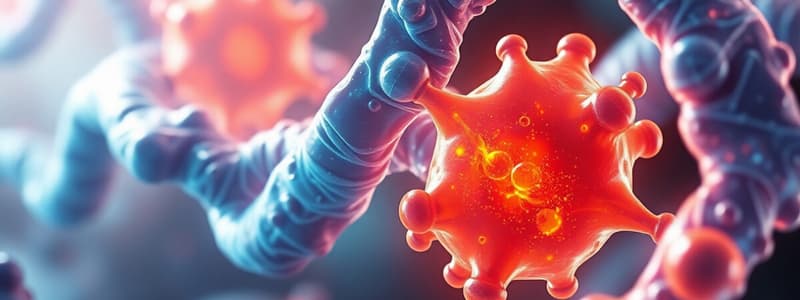Podcast
Questions and Answers
What suffix is commonly added to the substrate to form the name of an enzyme?
What suffix is commonly added to the substrate to form the name of an enzyme?
- -in
- -zyme
- -ose
- -ase (correct)
Which of the following represents the correct format for the enzyme classification system?
Which of the following represents the correct format for the enzyme classification system?
- EC | number | class | details
- EC (class) - YYYY
- EC - XX.XXX
- EC: [class]-[subclass]-[sub-subclass]-[particular enzyme] (correct)
Which enzyme is specifically responsible for breaking down lactose?
Which enzyme is specifically responsible for breaking down lactose?
- Lactase (correct)
- Amylase
- Sucrase
- Maltase
What does the first digit in the EC number of an enzyme represent?
What does the first digit in the EC number of an enzyme represent?
Which factor does NOT influence enzyme action?
Which factor does NOT influence enzyme action?
What is the primary function of enzymes in the body?
What is the primary function of enzymes in the body?
What is the specific location on an enzyme where substrates bind?
What is the specific location on an enzyme where substrates bind?
Which model suggests that the enzyme and substrate fit together like a key and lock?
Which model suggests that the enzyme and substrate fit together like a key and lock?
What are coenzymes primarily classified as?
What are coenzymes primarily classified as?
What happens to the enzyme after the substrate is transformed into products?
What happens to the enzyme after the substrate is transformed into products?
What is an enzyme-substrate complex?
What is an enzyme-substrate complex?
Which of the following best describes the induced fit model?
Which of the following best describes the induced fit model?
Which of these features is NOT characteristic of enzymes?
Which of these features is NOT characteristic of enzymes?
Flashcards are hidden until you start studying
Study Notes
Importance of Enzymes
- Enzymes are complex organic compounds crucial for speeding up chemical reactions in the body without changing themselves.
- Specificity is a key feature; each enzyme catalyzes one specific chemical reaction, enhancing reaction rates significantly.
Structure and Function
- Enzymes consist of active sites, where substrates bind, forming an enzyme-substrate complex.
- The reaction proceeds, transforming substrates into products, which are then released while the enzyme remains unchanged.
Models of Enzyme Action
- Lock and Key Model: Proposed by Emil Fischer, suggesting a rigid fit between substrate and enzyme, like a key in a lock.
- Induced Fit Model: Proposed by Daniel E. Koshland Jr., indicating that substrate binding induces conformational changes in the enzyme, facilitating the reaction.
Coenzymes and Cofactors
- Coenzymes are organic molecules that assist enzymes and bind loosely to them.
- Cofactors can be inorganic or organic and assist in substrate recruitment without permanent binding.
Enzyme Nomenclature
- Enzyme names often end in -ase, derived from either the substrate (e.g., lactase from lactose) or the type of reaction (e.g., oxidase).
- The systematic nomenclature includes the EC number, indicating enzyme class, subclass, and specific enzyme identity.
Biological Enzyme Examples
- Lipase: Breaks down fats.
- Protease: Breaks down proteins.
- Cellulase: Breaks down cellulose.
- Amylase: Breaks down starch.
- Sucrase: Breaks down sucrose.
- Maltase: Breaks down maltose.
- Lactase: Breaks down lactose.
Factors Influencing Enzyme Action
- Concentration of substrates and enzymes affect reaction rates.
- Temperature and pH levels can optimize or hinder enzyme effectiveness.
- Presence of accelerators can enhance enzyme action, while inhibitors can slow it down or stop it.
- Environmental hazards may negatively impact enzyme function.
Studying That Suits You
Use AI to generate personalized quizzes and flashcards to suit your learning preferences.




